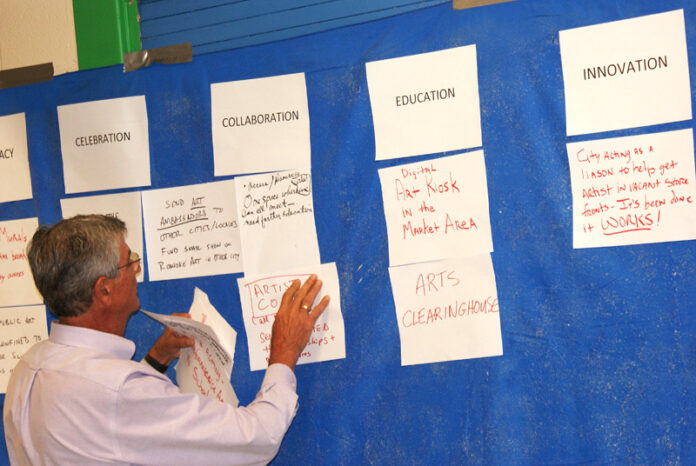
Roanoke’s economic development department is home to the city’s public art initiative, and also to an “Arts and Culture plan” being crafted by next spring. It’s designed to be a blueprint of sorts – how to give local artists the support they need to thrive, while they in turn help Roanoke become a more interesting and vibrant place. There’s an economic consideration as well: A survey released in January showed at least 255 arts-related businesses in Roanoke, employing 1723 people or more.
Roanoke City has held a series of meetings, more than a half dozen, with the most recent one focusing on the “creative class.” Director of Planning Tom Carr said the object was “to make a special effort to make sure we are talking to the artists themselves,” to be certain that all parties involved share “a common vision.”
The artists may have a ways to go when it comes to making an impact on the general public: a survey now being conducted by Roanoke City shows that the top three cultural assets in the city are considered to be the downtown Farmer’s Market, the greenway system and the assorted festivals held at venues like Elmwood Park – no museums or galleries at the top of the list.
Susan Jennings, director of the city’s public art program, told the several dozen gathered at Eureka Park last week that they were “essential to what we end up with,” as far as an arts and culture plan was concerned. The Roanoke Arts Commission is serving as a steering committee for the plan. Carr’s slide show included a quote from artist Brian Counihan, organizer of the Marginal Arts Festival: “if our local talent can work together we can produce something amazing.”
Carr declared that Roanoke “is an arts and cultural center. What we have lacked is an overall vision.” The object of crafting such a plan, which will be presented to the Planning Commission and City Council next spring, is to “get people moving in the same direction.” Roanoke already spends about two million dollars a year from its budget to support the arts – Carr figured that was higher proportionately than any other Virginia locality.
After being turned down for a grant from the National Endowment for the Arts to fund the survey work, Carr said the city decided to go ahead and do it anyway. “[We’re] relying on people in the community as our consultants.” Certain efforts must be incorporated into the plan: collaboration, education, innovation and inclusion among them. “How can arts and culture organizations help us with our goal?” asked Jennings.
Artists were broken up into groups at the Eureka Park meeting and were asked to answer this rather wordy question:What do we as a community need to do in order to become a vibrant and prosperous community, where innovation in arts and culture engages people in all aspects of life…while facilitating sustained economic growth and development?”
Participants wrote suggestions on sheets of paper, which were later tacked up on the wall. Among the ideas floated: local performing artists more involved with schools, more public murals, finding ways to get more people out for Art By Night, making vacant storefronts available to artists for working studios, venues where the under-21 crowd can listen to music, and sending an “art ambassador” from Roanoke to other cities.
“You’ve come up with a ton of ideas,” said facilitator Dan Merenda. “If the plan works,” he added, “it will create jobs and help young people become more involved.” A public meeting will be held early next year to get feedback on the arts and culture plan, after it is presented to the Roanoke Arts Commission in December.


